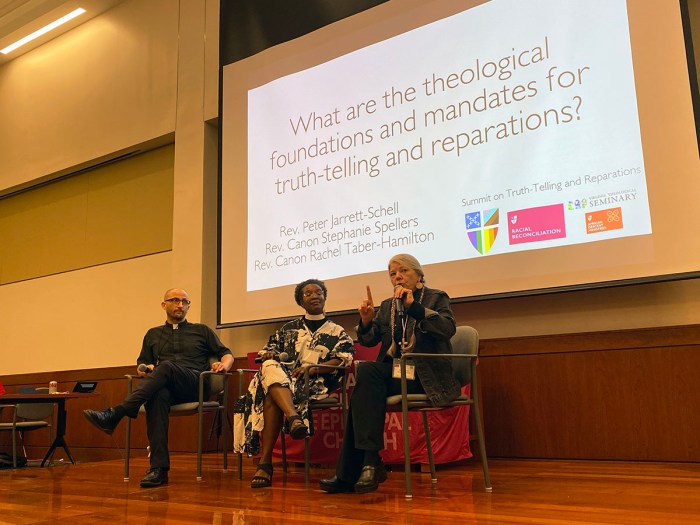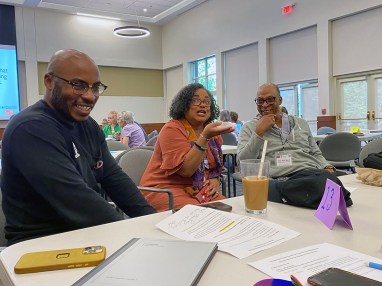
The Rev. Rachel Taber-Hamilton, rector of Trinity Episcopal Church in Everett, Washington, and the founder of Circles of Color, makes a point during a panel discussion on truth-telling Sept. 19 during the Summit on Truth-telling and Reparations held at Virginia Theological Seminary in Alexandria. The Rev. Stephanie Spellers, canon to the presiding bishop for reconciliation, justice and creation care, and the Rev. Peter Jarrett-Schell, who serves as pastor at Calvary Episcopal Church in Washington, D.C., look on. Photo: Lynette Wilson/Episcopal News Service
[Episcopal News Service – Alexandria, Virginia] The Rev. Lindsey Ardrey grew up among storytellers, but there were some stories the elders and the matriarchs didn’t want to tell, stories about harm and systems of oppression whispered to one another in hushed tones.
Ardrey shared her childhood memories with nearly 100 people representing 34 dioceses at the Sept. 19-21 Summit on Truth-telling and Reparations. It was an opportunity for Episcopal leaders to share strategies, best practices and resources and to pray for and encourage one another in their work.
“Because we are the church of the enslaved and enslaver, the Indigenous people and the colonizer, we are here to tell these stories in non-hushed tones,” Ardrey, the Diocese of North Carolina’s missioner for reparations and restitution ministries, told them.
The Episcopal Church’s Department of Reconciliation, Justice and Creation Care hosted the gathering for Episcopal lay and clergy leaders engaged in truth-telling and reparations ministries with support from the Office of African Descent Ministries and Virginia Theological Seminary, where the summit took place.
“These are folks in congregations and dioceses and Episcopal institutions who are looking deeply into their history … looking into the stories of elders. They’re digging [into the archives] and they’re finding out, OK, these are the things that we have done around race. These are the things that have been done on our behalf,” the Rev. Stephanie Spellers, canon to the presiding bishop for reconciliation, justice and creation care, told Episcopal News Service.
Ardrey encouraged those present to be mindful of how certain truths were landing in their bodies. “You are bringing yourself, your story into this space. … This is heart-centered work.”
The summit’s organizers designed panel presentations, working groups and table discussions around truth-telling, reckoning and discernment aimed at drawing out and sharing the wisdom of those doing racial justice work with an eye toward how to approach reparations, or the process to remember, repair, restore, reconcile and make amends for wrongs, as it is sometimes defined.

The Rev. Mark Chase, associate rector at All Saints Episcopal Church in Pasadena, California, left, the Rev. Altagracia Perez-Bullard, associate dean of multicultural ministries and assistant professor of practical theology at Virginia Theological Seminary, and the Rev. Ronald Byrd, The Episcopal Church’s missioner for African Descent Ministries, enjoy a light moment during a table discussion on Sept. 20. Photo: Lynette Wilson/Episcopal News Service
In practical terms, truth-telling means identifying theologies and practices to unearth and name historic and systemic racial injustices; reckoning takes the form of publicly owning and naming harms and injustices; and discernment is coming to a collective, agreed-upon definition of what constitutes healing and repair.
“It’s truth-telling, it’s reckoning, and then it’s reparations, which is a way of saying repair and healing of what was broken and what’s still broken,” Speller said. “There’s a critical mass engaged in this work right now; it’s time to learn from each other, bolster one another and grow the movement.”
Historical investigations often lead to uncomfortable truths – facts that some people would rather leave buried in the past. Yet the sins of racism and of racist, white-dominant systems persist and continue cycles of oppression. As one person put it in a debrief following the table discussions: “The injured party defines what repair is. Forgiveness is the hardest thing to ask for … especially when the vulnerable person has the least amount of power.”
And for white people, as another person said, reparations work mustn’t take the form of “performative truth-telling.”
“As white people, we’re incentivized not to do the deeper work,” the Rev. Gwynn Crichton, associate rector for community engagement at St. Paul’s Episcopal Church in Richmond, Virginia, said. “Whiteness is like an addiction.”
Members of Old Donation Episcopal Church in Virginia Beach, Virginia, uncovered some uncomfortable truths as part of their journey through Sacred Ground, the church’s antiracism film- and readings-based curriculum grounded in faith and aimed at educating white people.
“We learned that our church enslaved a woman named Rachel,” Dan Ries, one of the church’s lay leaders who also serves on the Diocese of Southern Virginia’s Repairers of the Breach Task Force, told ENS.
“Old Donation,” got its name thanks to a gift from its longest-serving rector’s estate, which also included enslaved people. “We know their names,” he said. “It became very important to dig into that history … and to honestly tell our story.”
Still today, Ries said, Old Donation is struggling with some of the church’s imagery, including a plaque dedicated to the Rev. Robert Dixon, the slave-owning priest. The church, however, has institutionalized its reckoning process by establishing a Becoming Beloved Community commission. To date, about 70 people, about 10% of what is a large congregation, have participated in Sacred Ground, he said.
The commission takes its name from the churchwide Becoming Beloved Community initiative, a practical and theological framework for working toward racial healing, justice and reconciliation. It was launched in 2017, following the election of the Most Rev. Michael Curry, the church’s first Black presiding bishop. He embraced racial reconciliation as one of the church’s top three priorities, along with evangelism and creation care, when his nine-year term began in 2015.
Then five years later a white police officer murdered 46-year-old George Floyd, a Black man, in Minneapolis, Minnesota, setting off historic protests.
With Floyd’s death, “the scales just dropped away from so many folk’s eyes,” Spellers said.
Five years ago, she said, she avoided the word “reparations,” because it would shut down a conversation. “Now we’re having a summit on truth-telling and reparations and didn’t have enough room for all the people who said they wanted to be part of it.”
Spellers’ team expected 50 or so people to register for the summit. Instead, they reached capacity with 106 registrations, and 20-plus on the waiting list.

The Janet Lipscomb of the Diocese of Washington, left, the Rev. Linda T. Wilson, of the Diocese of Pittsburgh, and Diane Pollard, of the Diocese of New York, participate in a small group table discussion on Sept. 20. Photo: Lynette Wilson/Episcopal News Service
Both Diana Pollard, a longtime lay leader in the Diocese of New York who serves on its reparations committee and as a member of Executive Council, and the Rev. Chris McCloud, who serves on the Diocese of Maryland’s reparations committee, noted during the panel discussion on “discerning” that not everyone, including people of color, support reparations.
In the Diocese of Washington, identifying an agreed-upon, contextual definition of reparations was an important first step in the diocese’s discernment process, the Rev. Glenna Huber, rector of the Church of the Epiphany in downtown Washington, D.C. and co-chair of the diocese’s reparations committee, told ENS.
From there, the diocese, which includes the District of Columbia and parts of Maryland, created policy and educational resources aimed at addressing anti-Black racism and building diocesan-wide racial equity.
This work is particularly important in the nation’s capital, which in the 1970s was a 70% majority Black city nicknamed the “Chocolate City.” Today, the Black population is less than 45%. The diocese, Huber said, might examine ways it contributed to the displacement of Black residents.
Meanwhile, while the church’s Sacred Ground curriculum is meant to educate white people about racism and systemic racism, the church’s Office of African Descent Ministries offers a curriculum for “Healing from Internalized Oppression.”
“Imagine being traumatized for 400 years without any therapy, conversation or work towards repentance,” the Rev. Ronald Bryd, the church’s missioner for African Descent Ministries, said during a Sept. 20 panel on “reckoning.”
Later, Byrd told ENS, “the Black Episcopal church is in crisis.” The Episcopal Church, he said, would be wise to focus its energy and resources on repairing the harm done to Black and Indigenous people in the church.
“Yes, the world needs reparations, the country needs reparations, but if we look internal, I think that we can make a big impact,” he said, adding it might entail offering financial assistance to struggling parishes, establishing mentorships and forming sister congregations like some international partnerships. “Otherwise, we’re going to wake up one day and there will be no Black Episcopal church.”
Some 2,000 people have accessed the curriculum, including Black, Hispanic and Indigenous people, and later this fall Byrd’s office will release an updated version.
The Rev. Brad Hauff, the church’s missioner for Indigenous ministries and an enrolled member of the Oglala Lakota Nation, was also on the reckoning panel.
“Indigenous people are typically left out of conversations about reparations, and part of that is because so many of us aren’t around anymore,” he said. “Most of our ancestors, their descendants are not here because they were tribes that were annihilated, and their land was taken.”
The theft amounts to no less than half the entire land mass of the Western Hemisphere and the killing of tens of millions of people.
“The truth about what happened to Indigenous people and how the church was involved in it, once those doors are open, it’s a terrifying thing to look at,” Hauff said, “It’s terrifying and it’s shameful, so most people don’t want to open that door. … If we don’t open it, then we participate in the particular genocide of Indigenous people, just in a more passive way.”
In the Diocese of Northern Michigan, which covers Michigan’s Upper Peninsula and includes five Native American reservations, Leora Tadgerson serves as director of reparations and justice. Before joining the diocese’s staff, Tadgerson, who grew up on the Bay Mills reservation in Chippewa County, taught Indigenous studies and Ojibwe language at Northern Michigan University in Marquette, where the diocese is headquartered.
Now, working for the diocese, she’s able to focus full time on community healing and building, and addressing the legacy of white-settler colonialism.
“We are looking at what white supremacy tactics are operating in the church right now, how to dismantle it and how to walk on in a good way,” Tadgerson told ENS. “It’s unpacking all of the difficult stuff it’s hard to talk about, that nobody wants to talk about, and then helping the church move through it.”
-Lynette Wilson is a journalist and managing editor for Episcopal News Service.


